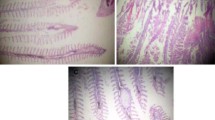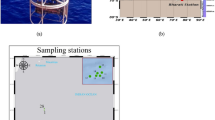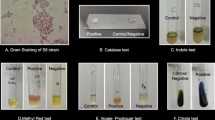Abstract
The Yamuna River, a tributary of the holy Ganga, is heavily polluted in the Delhi-NCR region, India and has been gaining attention due to the excessive foaming of the river over the past few years. This can be directly or indirectly related to the overuse of surfactants and the discharge of untreated domestic and textile wastewater into the river. To determine the surfactant load and investigate potential surfactant-degrading bacteria in the region, 96 water samples from four sites in the Okhla Barrage stretch of the river were collected and analysed. The results showed that the selected sites have surfactant concentrations more than the permissible limit (1.00 mgL−1). Also, at most of the sites, the concentration crossed the desirable limit of BIS (0.2 mgL−1) during the period of analysis. The concentration of anionic surfactant reported in the region was found in the range of 0.29 mgL−1 and 2.83 mgL−1. A total of 38 different bacteria were isolated using selective media from the same water samples, out of which 7 bacterial isolates were screened for sodium dodecyl sulphate (SDS) tolerance activity. Based on 16S rRNA gene sequencing, 2 species, namely Pseudomonas koreensis YRW-02 and Pseudomonas songnenensis YRW-05 have been identified and their degradation potential was assessed at different SDS concentrations. The results showed that our strains YRW-02 and YRW-05 degraded 78.29 and 69.24% of SDS respectively. Growth optimization was also performed at different substrate concentrations, pH, and temperature to investigate optimum degradation conditions. This study plays a significant role in assessing the surfactant load and also gives a promising background for future use in in-situ bioremediation experiments.







Similar content being viewed by others

Data Availability
All the data pertaining to this manuscript has been included in the manuscript.
References
Abdel-Megeed, A. (2013). Potential degradation of certain alkanes by Pseudomonas frederiksbergensis. J Pure Appl Microbiol, 7(3), 13–21.
APHA. (1998). Standard methods for examination of water and wastewater. American Public Health Association.
Arif, M., Kumar, R., & Parveen, S. (2020). Reduction in water pollution in Yamuna River due to lockdown under covid-19 pandemic. https://doi.org/10.26434/chemrxiv.12440525.v1
Arora, J., Ranjan, A., Chauhan, A., Biswas, R., Rajput, V. D., Sushkova, S., Mandzhieva, S., Minkina, T., & Jindal, T. (2022). Surfactant pollution, an emerging threat to ecosystem: Approaches for effective bacterial degradation. Journal of Applied Microbiology, 133(3), 1229–1244. https://doi.org/10.1111/jam.15631
Asim, M., & Nageswara Rao, K. (2021). Assessment of heavy metal pollution in Yamuna River, Delhi-NCR, using Heavy Metal Pollution Index and GIS. Environmental Monitoring and Assessment, 193(2). https://doi.org/10.1007/s10661-021-08886-6
Bhardwaj, R., Gupta, A., & Garg, J. (2017). Evaluation of Heavy Metal Contamination using environmetrics and indexing approach for river Yamuna, Delhi Stretch, India. Water Science, 31(1), 52–66. https://doi.org/10.1016/j.wsj.2017.02.002
Biswas, P., & Vellanki, B. P. (2021). Occurrence of emerging contaminants in highly anthropogenically influenced river Yamuna in India. Science of The Total Environment, 782, 146741. https://doi.org/10.1016/j.scitotenv.2021.146741
Bowes, M. J., Read, D. S., Joshi, H., Sinha, R., Ansari, A., Hazra, M., Simon, M., Vishwakarma, R., Armstrong, L. K., Nicholls, D. J., Wickham, H. D., Ward, J., Carvalho, L. R., & Rees, H. G. (2020). Nutrient and microbial water quality of the Upper Ganga River, India: Identification of Pollution Sources. Environmental Monitoring and Assessment, 192(8). https://doi.org/10.1007/s10661-020-08456-2
Brief on the Yamuna: WHAT AILS THE YAMUNA?. (2021). Retrieved 19 October 2022, from https://www.cseindia.org/brief-on-the-yamuna-what-ails-the-yamuna--11059
Bureau of Indian Standards (BIS). (1991). Specification for drinking water 1S:10500: Bureau of Indian Standards, New Delhi
Central Pollution Control Board. (2020). Alternative treatment technologies for wastewater treatment in drains In Compliance to Direction of Hon’ble NGT in the Matter of OA No. 06/2012 Titled Manoj Mishra Vs Union of India & ORS.
Chaturvedi, V., & Kumar, A. (2011). Diversity of culturable sodium dodecyl sulfate (SDS) degrading bacteria isolated from detergent contaminated ponds situated in Varanasi City, India. International Biodeterioration & Biodegradation, 65(7), 961–971. https://doi.org/10.1016/j.ibiod.2011.07.005
Chauhan, A., & Jindal, T. (2020). Microbiological methods for environment, food and pharmaceutical analysis. Springer Nature.
Chauhan, A., Bharti, P., Goyal, P., Varma, A., & Jindal, T. (2015). Psychrophilic pseudomonas in antarctic freshwater lake at stornes peninsula, larsemann hills over east Antarctica. Springerplus, 4(1). https://doi.org/10.1186/s40064-015-1354-3
CPCB. (1980–1981). The Ganga River—Part I—The Yamuna basin, ADSORBS/2. Delhi: Central Pollution Control Board.
Dehghani, M. H., Zarei, A., & Yousefi, M. (2019). Efficiency of ultrasound for degradation of an anionic surfactant from water: Surfactant determination using methylene blue active substances method. MethodsX, 6, 805–814. https://doi.org/10.1016/j.mex.2019.03.028
Fedeila, M., Hachaïchi-Sadouk, Z., Bautista, L. F., Simarro, R., & Nateche, F. (2018). Biodegradation of anionic surfactants by alcaligenes faecalis, Enterobacter cloacae and serratia marcescens strains isolated from industrial wastewater. Ecotoxicology and Environmental Safety, 163, 629–635. https://doi.org/10.1016/j.ecoenv.2018.07.123
Gentile, G., Bonsignore, M., Santisi, S., Catalfamo, M., Giuliano, L., Genovese, L., Yakimov, M. M., Denaro, R., Genovese, M., & Cappello, S. (2016). Biodegradation potentiality of psychrophilic bacterial strain Oleispira antarctica RB-8 T. Marine Pollution Bulletin, 105(1), 125–130. https://doi.org/10.1016/j.marpolbul.2016.02.041
Ghose, N. C., Saha, D., & Gupta, A. (2009). Synthetic detergents (Surfactants) and organochlorine pesticide signatures in surface water and groundwater of greater kolkata, india. Journal of Water Resource and Protection, 1(4), 290–298. https://doi.org/10.4236/jwarp.2009.14036
Govarthanan, M., Ameen, F., Kamala-Kannan, S., Selvankumar, T., Almansob, A., Alwakeel, S. S., & Kim, W. (2020). Rapid biodegradation of chlorpyrifos by plant growth-promoting psychrophilic Shewanella sp. BT05: An eco-friendly approach to clean up pesticide-contaminated environment. Chemosphere, 247, 125948. https://doi.org/10.1016/j.chemosphere.2020.125948
Halmi, M. I. E., Hussin, W. S. W., Aqlima, A., Syed, M. A., Ruberto, L. A. M., MacCormack, W. P., & Yukor, M. Y. (2013). Characterization of a sodium dodecyl sulphate-degrading Pseudomonas sp. strain DRY15 from Antarctic soil.
ISO 7875‐1. (1996). Water quality—determination of surfactants—part 1: determination of anionic surfactants by measurement of the methylene blue index (MBAS).
Ivon, E. A., Ubi, G. M., Etangetuk, N. A., Anyanwu, C. O., Nkang, A. N., & Ekanem, A. P. (2020). Toxic Potentials of Nittol Detergent on Haematological Parameters of African Catfish (Clarias gariepinus) in Nigeria. Annual Research & Review in Biology, 35(4), 53–67.
Jaiswal, M., Hussain, J., Gupta, S. K., Nasr, M., & Nema, A. K. (2019). Comprehensive evaluation of water quality status for entire stretch of Yamuna River, India. Environmental Monitoring and Assessment, 191(4), 1–17.
John, E. M., Rebello, S., Asok, A. K., & Jisha, M. S. (2015). Pseudomonas plecoglossicida S5, a novel nonpathogenic isolate for sodium dodecyl sulfate degradation. Environmental Chemistry Letters, 13(1), 117–123.
Kaczerewska, O., Martins, R., Figueiredo, J., Loureiro, S., & Tedim, J. (2020). Environmental behaviour and ecotoxicity of cationic surfactants towards marine organisms. Journal of Hazardous Materials, 392, 122299. https://doi.org/10.1016/j.jhazmat.2020.122299
Khan, A. H., Aziz, H. A., Khan, N. A., Dhingra, A., Ahmed, S., & Naushad, M. (2021). Effect of seasonal variation on the occurrences of high-risk pharmaceutical in drain-laden surface water: A risk analysis of Yamuna River. Science of The Total Environment, 794, 148484. https://doi.org/10.1016/j.scitotenv.2021.148484
Khleifat, K. M. (2006). Biodegradation of sodium lauryl ether sulfate (Sles) by two different bacterial consortia. Current Microbiology, 53(5), 444–448. https://doi.org/10.1007/s00284-006-0266-4
Dziewit, L., & Bartosik, D. (2014). Plasmids of psychrophilic and psychrotolerant bacteria and their role in adaptation to cold environments. Frontiers in Microbiology, 5. https://doi.org/10.3389/fmicb.2014.00596
Morita, R. Y. (1975). Psychrophilic bacteria. Bacteriological reviews, 39(2), 144–167.
Kishore, S., Malik, S., Shah, M. P., Bora, J., Chaudhary, V., Kumar, L., … Ranjan, A. (2022). A comprehensive review on removal of pollutants from wastewater through microbial nanobiotechnology -based solutions. Biotechnology and Genetic Engineering Reviews. https://doi.org/10.1080/02648725.2022.2106014
Kolsal, F., et al. (2017). Hydrocarbon degradation abilities of psychrotolerant bacillus strains. AIMS Microbiology, 3(3), 467–482. https://doi.org/10.3934/microbiol.2017.3.467
Kumar, S., Stecher, G., Li, M., Knyaz, C., & Tamura, K. (2018). MEGA X: Molecular Evolutionary Genetics Analysis across computing platforms. Molecular Biology and Evolution, 35, 1547–1549.
Kumar, M., Sharif, M., & Ahmed, S. (2019). Impact of urbanization on the river Yamuna Basin. International Journal of River Basin Management, 18(4), 461–475. https://doi.org/10.1080/15715124.2019.1613412
Kumar, A., Ranjan, A., Gulati, K., Thakur, S., & Jindal, T. (2016). Assessment of chemical and microbial contamination in groundwater through leaching of sewage waste in Delhi, India. Environmental Earth Sciences, 75(3). https://doi.org/10.1007/s12665-015-5016-0
Kumar, V., Sahu, P., K. Singh, P., K. Shukla, N., Mishra, D. P., & Markandeya. (2021). Evaluation and quantification of anionic surfactant in the gomti river at lucknow city, india. In I. Ahmed Moujdin & J. Kevin Summers (Eds.), Promising Techniques for Wastewater Treatment and Water Quality Assessment. IntechOpen. https://doi.org/10.5772/intechopen.93517
Kumari, A., Rajput, V. D., Mandzhieva, S. S., Rajput, S., Minkina, T., Kaur, R., … Glinushkin, A. P. (2022). Microplastic pollution: An emerging threat to terrestrial plants and insights into Its remediation strategies. Plants, 11(3). https://doi.org/10.3390/plants11030340
Li, Y., Hu, H., & Wu, Q. (2007). Isolation and characterization of psychrotrophic nitrobenzene-degrading strains from river sediments. Bulletin of Environmental Contamination and Toxicology, 79(3), 340–344. https://doi.org/10.1007/s00128-007-9239-y
M. Abd-Elnaby, H., M. Abou-Elela, G., Hussein, H., A. Ghozlan, H., & A. Sabry, S. (2019). Characterization and Bioremediation potential of marine psychrotolerant Pseudomonas spp. isolated from the Mediterranean Sea, Egypt. Egyptian Journal Of Aquatic Biology And Fisheries, 23(4), 669–683. https://doi.org/10.21608/ejabf.2019.63537
Malik, D., Singh, S., Thakur, J., Singh, R. K., Kaur, A., & Nijhawan, S. (2014). Heavy metal pollution of the Yamuna River: An introspection. International Journal of Current Microbiology and Applied Sciences, 3(10), 856–863.
Markúsdóttir, M., Heiðmarsson, S., Eyþórsdóttir, A., Magnússon, K. P., & Vilhelmsson, O. (2013). The natural and anthropogenic microbiota of Glerá, a sub-arctic river in northeastern Iceland. International Biodeterioration & Biodegradation, 84, 192–203. https://doi.org/10.1016/j.ibiod.2012.04.001
Miri, S., Rasooli, A., Brar, S. K., Rouissi, T., & Martel, R. (2022). Biodegradation of p-xylene—A comparison of three psychrophilic Pseudomonas strains through the lens of gene expression. Environmental Science and Pollution Research, 29(15), 21465–21479. https://doi.org/10.1007/s11356-021-17387-5
Misra, A. K. (2010). A river about to die: Yamuna. Journal of water resource and protection, 2(5), 489.
Okpokwasili, G. C., & Olisa, A. O. (1991). River-water biodegradation of surfactants in liquid detergents and shampoos. Water Research, 25(11), 1425–1429. https://doi.org/10.1016/0043-1354(91)90121-6
Pandey, P., Khillare, P., & Kumar, K. (2011). Assessment of organochlorine pesticide residues in the surface sediments of river Yamuna in Delhi, India. Journal of Environmental Protection, 02(05), 511–524. https://doi.org/10.4236/jep.2011.25059
Parween, M., Ramanathan, A., & Raju, N. J. (2021). Assessment of toxicity and potential health risk from persistent pesticides and heavy metals along the Delhi stretch of river Yamuna. Environmental Research, 202, 111780. https://doi.org/10.1016/j.envres.2021.111780
Patel, R., & Patel, K. S. (1998). Flow injection determination of anionic surfactants with cationic dyes in water bodies of central India. The Analyst, 123(8), 1691–1695. https://doi.org/10.1039/a802945h
Rai, R. K., Upadhyay, A., Ojha, C. S., & Singh, V. P. (2011). Water pollution. Water Science and Technology Library, 245–275. https://doi.org/10.1007/978-94-007-2001-5_9
Ramanjulu, C., Naidu, N. V., Kanchi, S., & Bisetty, K. (2015). Seasonal variation and distribution of anionic surfactants in and around Tirupati: a famous pilgrim centre in South India. Asian Journal of Chemistry.
Rathour, R., Gupta, J., Tyagi, B., Kumari, T., & Thakur, I. S. (2018). Biodegradation of pyrene in soil microcosm by Shewanella sp. ISTPL2, a psychrophilic, alkalophilic and halophilic bacterium. Bioresource Technology Reports, 4, 129–136. https://doi.org/10.1016/j.biteb.2018.10.004
Said, S., & Hussain, A. (2019). Pollution mapping of Yamuna River segment passing through Delhi using high-resolution geoeye-2 imagery. Applied Water Science, 9(3). https://doi.org/10.1007/s13201-019-0923-y
Sepehr, S., Shahnavaz, B., Asoodeh, A., & Karrabi, M. (2019). Biodegradation of phenol by cold-tolerant bacteria isolated from alpine soils of Binaloud Mountains in Iran. Journal of Environmental Science and Health, Part A, 54(4), 367–379. https://doi.org/10.1080/10934529.2018.1553818
Seth, R., Singh, P., Mohan, M., Singh, R., & Aswal, R. S. (2013). Monitoring of phenolic compounds and surfactants in water of Ganga Canal, Haridwar (India). Applied Water Science, 3(4), 717–720. https://doi.org/10.1007/s13201-013-0116-z
Shahbazi, R., Kasra-Kermanshahi, R., Gharavi, S., Moosavi-Nejad, Z., & Borzooee, F. (2013). Screening of SDS-degrading bacteria from car wash wastewater and study of the alkylsulfatase enzyme activity. Iranian Journal of Microbiology, 5(2), 153.
Sharma, M. P., Singal, S. K., & Patra, S. (2009). Water quality profile of Yamuna River, India. Hydro Nepal: Journal of Water, Energy and Environment, 3, 19–24. https://doi.org/10.3126/hn.v3i0.1914
Sharma, R., Kumar, R., Satapathy, S. C., Al-Ansari, N., Singh, K. K., Mahapatra, R. P., . . . Pham, B. T. (2020). Analysis of water pollution using different physicochemical parameters: A study of Yamuna River. Frontiers in Environmental Science, 8. https://doi.org/10.3389/fenvs.2020.581591
Siddiqui, Z. H., Wattal, R. K., Batchu, H., & Abbas, Z. K. (2020). Assessment of cytotoxic and genotoxic effects of Yamuna River water pollutants in an urban metropolis, Delhi (India). Water Supply, 20(7), 2682–2697. https://doi.org/10.2166/ws.2020.165
Singh, K. K., & Vaishya, R. C. (2016). Isolation of bacterial isolates from municipal wastewater for bioremediation of anionic surfactants. International Journal of Scientific Progress & Research, 23(3), 181–185.
Sundararaman, S., Kumar, J. A., Deivasigamani, P., & Devarajan, Y. (2022). Emerging pharma residue contaminants: Occurrence, monitoring, risk and fate assessment–A challenge to water resource management. Science of the Total Environment, 825, 153897.
Thathola, P., Agnihotri, V., Pandey, A., & Upadhyay, S. K. (2022). Biodegradation of bisphenol A using psychrotolerant bacterial strain Pseudomonas palleroniana GBPI_508. Archives of Microbiology, 204(5), 272. https://doi.org/10.1007/s00203-022-02885-y
Verma, S., & Chatterjee, S. (2021). Biodegradation of profenofos, an acetylcholine esterase inhibitor by a psychrotolerant strain Rahnella sp PFF2 and degradation pathway analysis. International Biodeterioration & Biodegradation, 158, 105169. https://doi.org/10.1016/j.ibiod.2020.105169
Verma, S., Singh, D., & Chatterjee, S. (2021). Malathion biodegradation by a psychrotolerant bacteria Ochrobactrum sp. M1D and metabolic pathway analysis. Letters in Applied Microbiology, 73(3), 326–335. https://doi.org/10.1111/lam.13517
Yeldho, D., Rebello, S., & Jisha, M. (2010). Plasmid-Mediated Biodegradation of the Anionic Surfactant Sodium Dodecyl Sulphate, by Pseudomonas aeruginosa S7. Bulletin Of Environmental Contamination And Toxicology, 86(1), 110–113. https://doi.org/10.1007/s00128-010-0162-2
Yilmaz, F., & Icgen, B. (2014). Characterization of SDS-degrading Delftia acidovorans and in situ monitoring of its temporal succession in SDS-contaminated surface waters. Environmental Science and Pollution Research, 21(12), 7413–7424. https://doi.org/10.1007/s11356-014-2653-x
Zargar, A.R. (2019). Hindu festival in India marred by a river of toxic foam and a blanket of killer smog. CBS News, 5th November. Available at: https://www.cbsnews.com/news/yamuna-rivers-toxic-foam-and-delhi-air-pollution-greet-india-hindu-devotees-for-chhath-puja-festival
Zhu, X., Wang, Z., Sun, Y., Gu, L., Zhang, L., Wang, J., Huang, Y., & Yang, Z. (2020). Surfactants at environmentally relevant concentrations interfere the inducible defense of scenedesmus obliquus and the implications for ecological risk assessment. Environmental Pollution, 261, 114131. https://doi.org/10.1016/j.envpol.2020.114131
Acknowledgements
The authors are grateful to the Founder President of Amity University, Dr. Ashok K Chauhan for his constant support and encouragement. The research was supported by the Strategic Academic Leadership Program of the Southern Federal University ("Priority 2030").
Author information
Authors and Affiliations
Contributions
JA, AC, AR: Conceptualization; JA, AR, AC: Methodology; JA, AC, AR, SJ, RP: Formal analysis; AC, TJ: Resources; JA, AC, AR: Data curation; JA: Writing-original draft preparation; AB, AR, AC, RB, SJ, RP: Writing-review and editing; VR, SS, EP, TM, SJ, RP: Critical review and editing; AC, AR, RP, TJ: Supervision. All the authors read and approved the final version of the manuscript.
Corresponding authors
Ethics declarations
Ethical approval
This article does not contain any studies with human participants or animals.
Consent to Participate
All authors agree mutually with the participation and publication of this work and declare that this is original research.
Consent to publish
All authors agree mutually to publication of this work.
Conflict of Interest
The authors report no financial or any other conflicts of interest in this work.
Additional information
Publisher's Note
Springer Nature remains neutral with regard to jurisdictional claims in published maps and institutional affiliations.
Rights and permissions
Springer Nature or its licensor (e.g. a society or other partner) holds exclusive rights to this article under a publishing agreement with the author(s) or other rightsholder(s); author self-archiving of the accepted manuscript version of this article is solely governed by the terms of such publishing agreement and applicable law.
About this article
Cite this article
Arora, J., Ranjan, A., Chauhan, A. et al. A Novel Study on Anionic Surfactant Degradation Potential of Psychrophillic and Psychrotolerant Pseudomonas spp. Identified from Surfactant-contaminated River Water. Appl Biochem Biotechnol (2023). https://doi.org/10.1007/s12010-023-04647-y
Accepted:
Published:
DOI: https://doi.org/10.1007/s12010-023-04647-y



